May be we all know that we are the part of a ecosystem. The term ecosystem may be short but it’s expanse is very wide from desert to polar region, pond to ocean, grassland to forest. All sorts of organisms do interact and mixes up in a ecosystem and the organisms vary from ecosystem to ecosystem. No living organism in the world can live without the help of other living as well as non living things and we human beings also fall in this category.
An ecosystem consists many different components such as abiotic (light, minerals, water, air etc), biotic (plants, consumers, animals, microorganisms etc) things. And moreover an ecosystem can be various types for example freshwater ecosystem, forest ecosystem, desert ecosystem, saline water or marine ecosystem etc.
If you feel interest to read and get effective informations about a freshwater ecosystem of a common Bangladeshi river named Bangshai river, this article is for you. But the matter is you can know about ecosystem definition, classification, Bangshai river’s geographical location, ecosystem type, the abiotic factors and from the biotic factor only primary producer of Bangshai river ecosystem have been discussed in Part 1.
Now we will discuss about river ecosystem’s consumers, decomposers, resources, threats and so on.
Bangshai River Ecosystem
As we have already discussed the primary producer of this ecosystem, we are about to talk the consumers that are dependent on the producers for their overall livelihood. They also play a crucial role in a ecosystem just like producers.
Consumers
Consumers of an ecosystem cannot make their own food. They depend on producers for their food and energy. Consumers are heterotrophs that depend on autotrophs for their food and energy.The consumers of a freshwater biome include snails, insects, crustaceans, amphibians, fish, and aquatic birds. Consumers have adaptations as well-
- Animals, like fish, that absorb oxygen directly from the water have a flat, thin body allowing for increased surface area.
- Their streamlined bodies also help with swimming and allow them to rest by nosing into a river current.
- Others have suction-cup like structures on their bodies that allow them to hold on to rocks and the river bottom in fast moving waters.
- Others are adapted to the calm, still water of lakes and ponds by being able to grab and store oxygen. Some are so lightweight they can skid across the top of the water in search of food.
Heterotrophs can be classified by what they usually eat as herbivores, carnivores, omnivores as well as what are their roles in ecology as primary/ secondary/ tertiary consumer.
In Bangshai river ecosystem, consumers are of 3 types:
- Primary consumer: Primary consumers are the organisms that feed on primary producers. They are consumed by secondary and tertiary consumers. Furthermore, as they feed on primary producers, which are the autotrophic plants, primary consumers are herbivores. Primary consumers have effective mechanisms for the breakdown of carbohydrates. Carbohydrates are the simple organic compounds produced during the fixation of energy by photosynthesis.
Primary consumers which typically include insects, molluscs such as snails, crustaceans such as freshwater crayfish and worms, snails, insects, crustaceans, amphibians, fish, and aquatic birds.. Primary consumers also include microscopic zooplankton that graze on the Phytoplankton (microscopic plants). - Secondary Consumer: Secondary consumers are animals that feed on primary consumers. However, they are consumed by tertiary consumers. Secondary consumers can be either carnivores or omnivores. That means, carnivores feed only on primary consumers. But, omnivores feed on both primary consumers and primary producers. They widely range in size and shape. Certain aquatic insects are carnivores and feed upon primary consumers, the zooplankton.
So secondary consumers which are mainly small fish but also include the larvae of insects such as the dobsonfly and stonefly, some aquatic birds, frogs etc. - Tertiary Consumer:A tertiary consumer is an organism that obtains its nutrition by eating primary consumers and secondary consumers. Usually tertiary consumers are carnivorous predators, although they may also be omnivores, which feed on both meat and plant material. Tertiary consumers living in an aquatic environment might include fish species such as cutthroat trout, river otter, great blue heron, eels, birds and even humans. Sometimes snails can be the tertiary consumers as they feed on aquatic frogs and frogs feed on insects.
Decomposer
Decomposers play a critical role in the flow of energy through an ecosystem. They break apart dead organisms into simpler inorganic materials, making nutrients available to primary producers.
Most freshwater decomposers like bacteria and fungi are on the bottom of rivers and lakes. This is where dead organisms and plants are found along with dead plant matter that enters the water from terrestrial sources. Decomposers continually replenish the nutrients in the soil by breaking down dead material through the use of biochemical and chemical reactions.
the decomposers are mostly found at the bed of the river.
Some decomposers in the freshwater biome are fungi, bacteria, and earth worms.
In Bangshai river, as far as I noticed, I found many animal species that play as heterotrophs as well as consumers of the water ecosystem and some specific decomposers there. I would like to provide their list below:
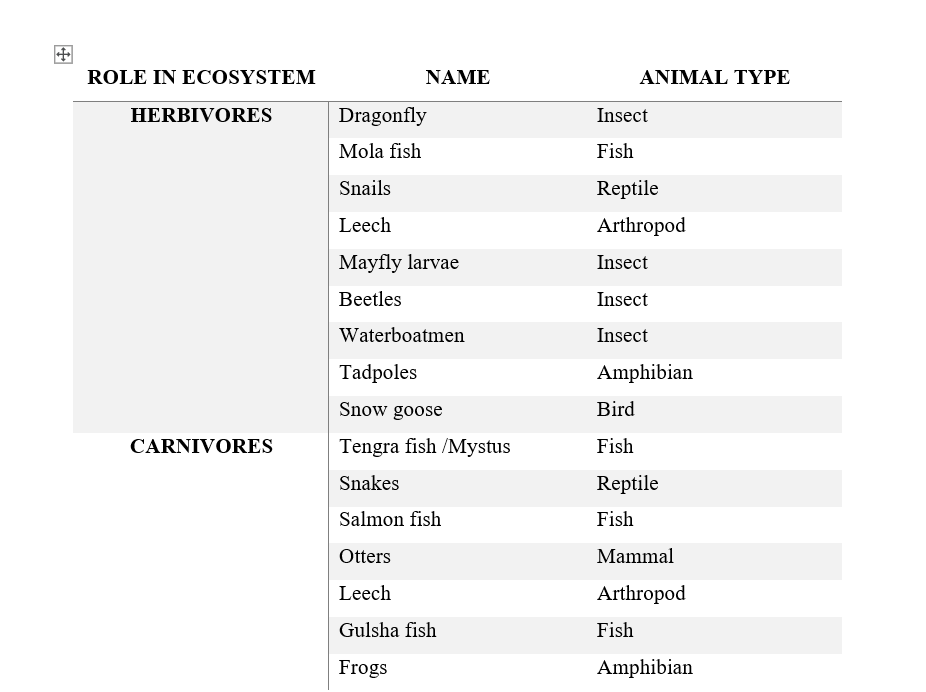
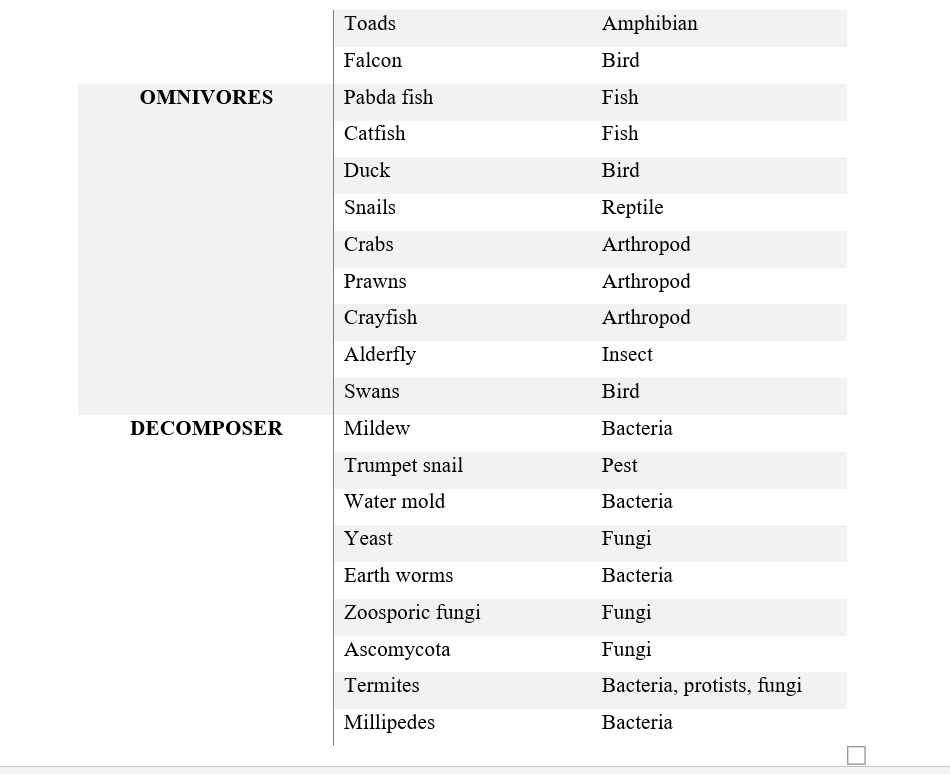
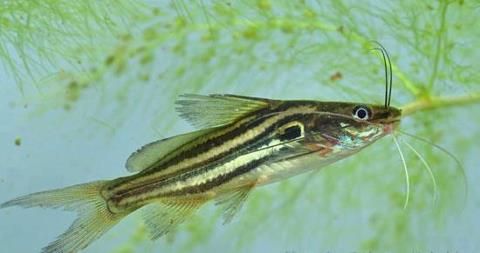
Ecological linkage
All the individual of an ecosystem are interdependent on each other for their food and for being survived on earth. Those organisms in the earth can not have the ability to win in the ecological war, ultimately they are being extinct and this have been happening from the very early age of earth since the life have emerged. So every living organism must struggle to survive. Exactly this phenomenon creates the linkage in ecology as well as in a particular ecosystem. Eventually this ecological linkage comes out as the terms food chain, food web, food pyramid, energy pyramid, mutualism and so many.
Food chain
A food chain is a linear network of links in a food web starting from producer organisms and ending at an apex predator species, detritivores, or decomposer species. A food chain also shows how organisms are related to each other by the food they eat. Each level of a food chain represents a different trophic level for example- When a large fish eats small fish which eats water fleas and water fleas in turn eat phytoplanktons ,it is called a aquatic food chain. In Bangshai river ecosystem, some considerable food chain will be-
- Bacteria→Crayfish→Ducks
- Beetles→Tengra fish→ Heron→Crocodile
- Algae→Beetles→Small baby craps→Katla fish→Human
- Zooplankton→Mayfly→Frog→Snake→Falcon
Food web
A food web consists of all the food chains in a single ecosystem. Each living thing in an ecosystem is part of multiple food chains. Each food chain is one possible path that energy and nutrients may take as they move through the ecosystem. Example- Multiple food chain being mixed up and create a large food web. In case of Bangshai River ecosystem, we can consider a food web like this-
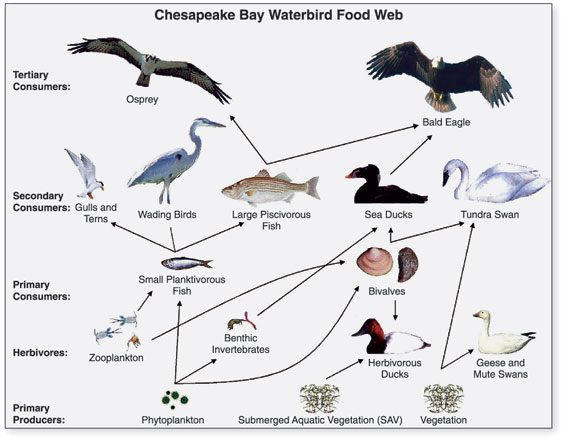
Interdependency
All organisms in an ecosystem depend upon each other. If the population of one organism rises or falls, then this can affect the rest of the ecosystem. This means that all the organisms in an ecosystem are dependent upon each other. All living things depend on their environment to supply them with what they need, including food, water, and shelter. This is known as interdependence. For example, living things that cannot make their own food must eat other organisms for food. The partnership between nitrogen-fixing bacteria and leguminous plants is one example.
Mutualism describes the ecological interaction between two or more species where each species has a net benefit. Mutualism is a common type of ecological interaction.
Each component of an ecosystem is dependent on others for food and energy. This depending system creates a ecological pyramid. An energy pyramid, also known as a trophic or ecological pyramid, is a graphical representation of the energy found within the trophic levels of an ecosystem. The bottom and largest level of the pyramid is the producers and contains the largest amount of energy.
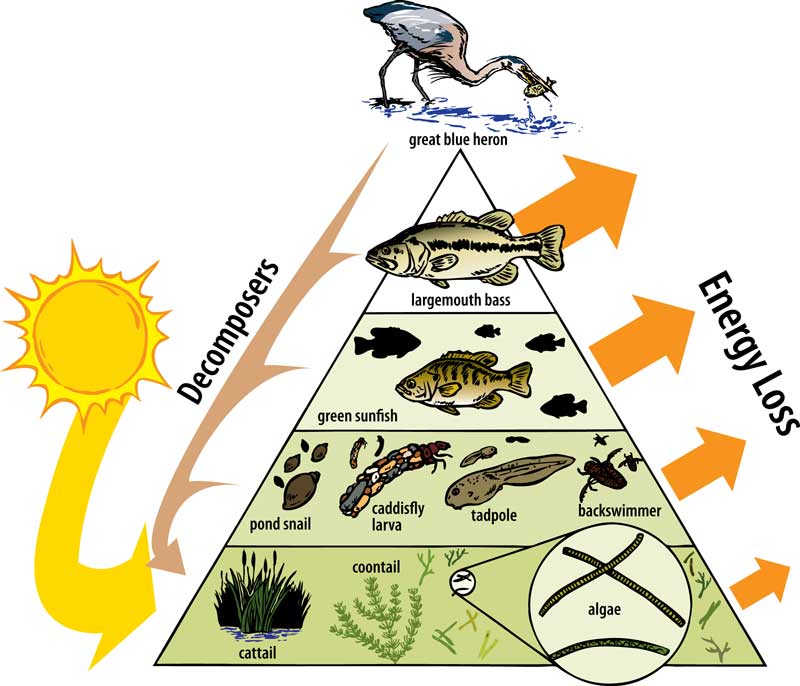
From Bangshai river ecosystem, I have tried to make a diagram of ecological energy pyramid-
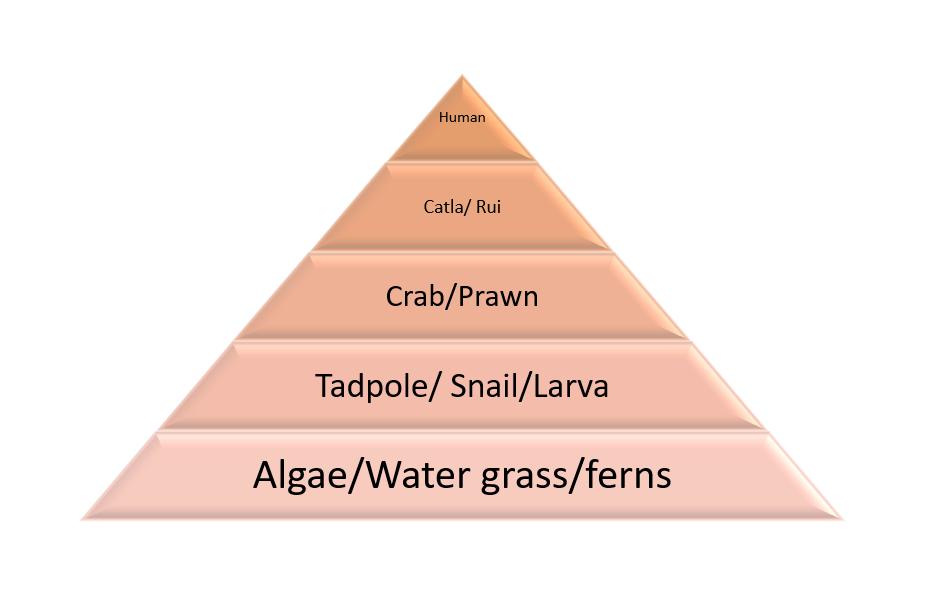
Ecosystem services
Ecosystem services are the many and varied benefits to humans provided by the natural environment and from healthy ecosystems.
- Provisioning service: A provisioning service is any type of benefit to people that can be extracted from nature.From river, people cane get some provisioning services such as-
- Supply of drinking water,
- Water used in cultivation,
- Boat, launch, steamer, troller boat transport various goods like rice, silica, soil, food products etc to desired location,
- Fish production and economy,
- People of riverside slums and houses fully depend on river for their regular activities,
- Generating power and navigation,
- Jute rotting and marketing,
- Some specific crop plants are grown well in river bank,
- Public transport,
- Some river plants have excellent quality of herbal medicine.
- Regulatory services: A regulating service is the benefit provided by ecosystem processes that moderate natural phenomena.
It includes-- Decomposition,
- Erosion and flood control,
- Carbon storage and climate regulation,
- Oxygen and Carbon dioxide balance,
- In the total photosynthesis rate on earth, algae from aquatic body contribute 50-60% of it, that keep balanced of the earth’s atmosphere,
- Role in nutrient cycle,
- Maintenance of water quality- natural filtration and water treatment,
- Buffering of flood flows,
- Erosion control through water/ land interaction,
- Flood control infrastructure,
- Anabaena, nostoc and other organism from river regulate the Nitrogen cycle,
- Maintain hydrological system.
- Cultural services: Cultural Ecosystem Services (CES) are the non-material benefits people obtain from nature. They include recreation, aesthetic enjoyment, physical and mental health benefits and spiritual experiences.River provides cultural services-
-
- Recreation- river rafting, kayaking, hiking and fishing,
- Tourism- River viewing,
- Personal satisfaction from free flowing river,
- Spiritual experience related to the natural environment,
- Using of many river plants (Lily, lotus) in religious ritual,
- Some more religious ritual like drown of goddess in Hinduism, Ash of burning dead-body discharging in river etc
- Picnics, boat journey, adventure.
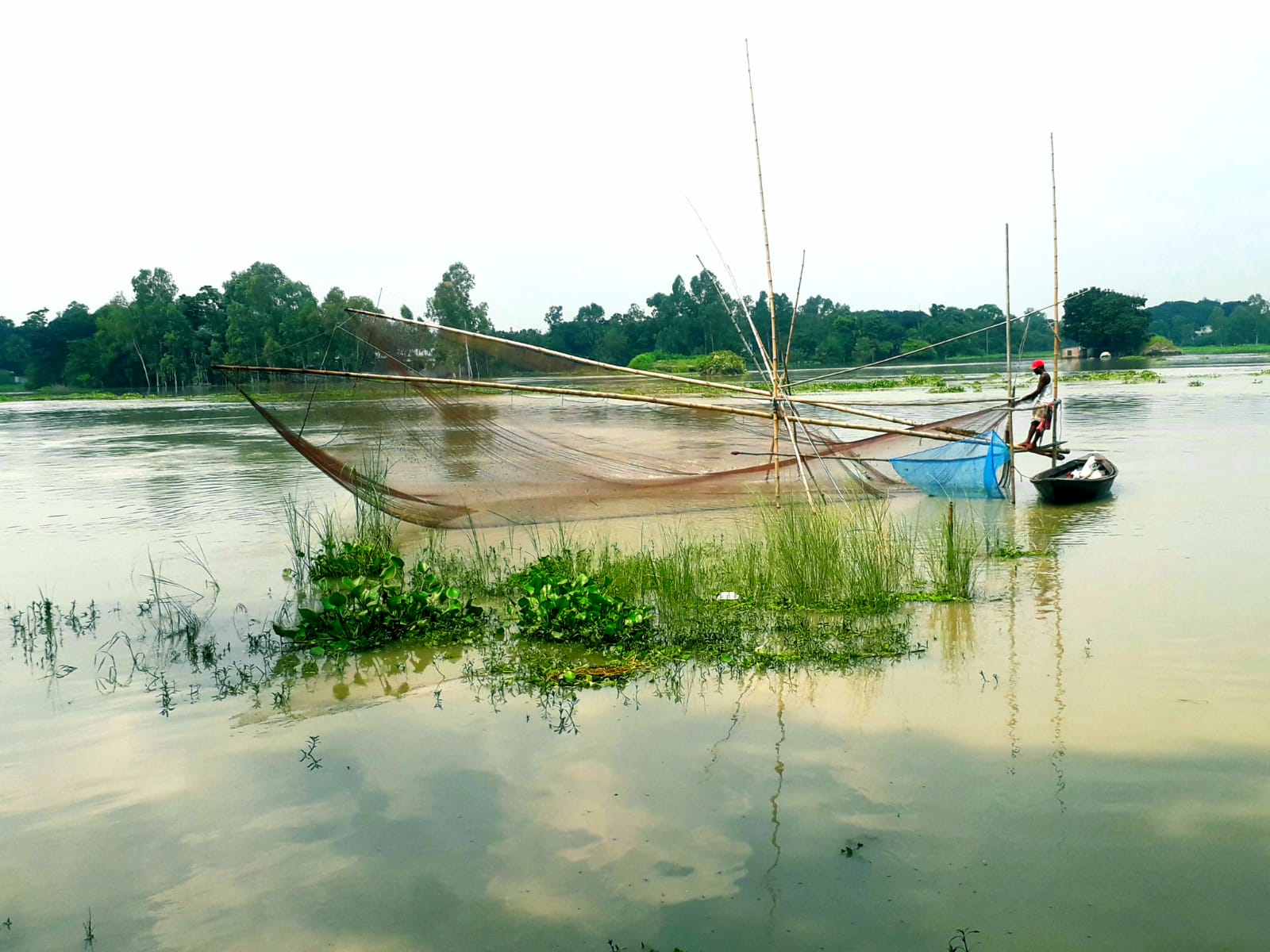
Threats to the ecosystem
Anything that attempts to alter the balance of the ecosystem potentially threatens the health and existence of that ecosystem. Some of these threats are not overly worrying as they may be naturally resolved provided the natural conditions are restored.
Freshwater ecosystems are essential for human survival, providing the majority of people’s drinking water. This ecosystems are home to more than 40 percent of the world’s fish species. Despite their value and importance, many lakes, rivers, and wetlands around the world are being severely damaged by human activities and are declining at a much faster rate than terrestrial ecosystems.
Human activities pose threats to river ecosystems.
As I am talking about Bangshai river, the common undesirable human activities are-
- Brick field in river bank throw waste material
- Troller boats extract oil directly to river water
- Mills, factories of riverside give all their wastes to river
- People who live near the river throw their regular domestic waste into river
- Some places, I noticed toilets in the river bank that are joint with river
- Some unexpected construction like bridge, culvert also ruin river flow balance ultimately the ecosystem in it
- High use of pesticides, fertilizers drained in the river by rain water and affect the pH content in it, which affect ecosystem
- Construction in river bank also narrows the river bed that is a threat for plant and animal species in it
- High chemical content pollute river water and somewhere there can be seen dead fishes or other consumers float on surface.
All the stuffs create a huge threat for existance of the biotic organism in the Bangshai river and moreover imbalance the environment. One day the river will be a dead river and unsuitable for any ecosystem to grow in this.
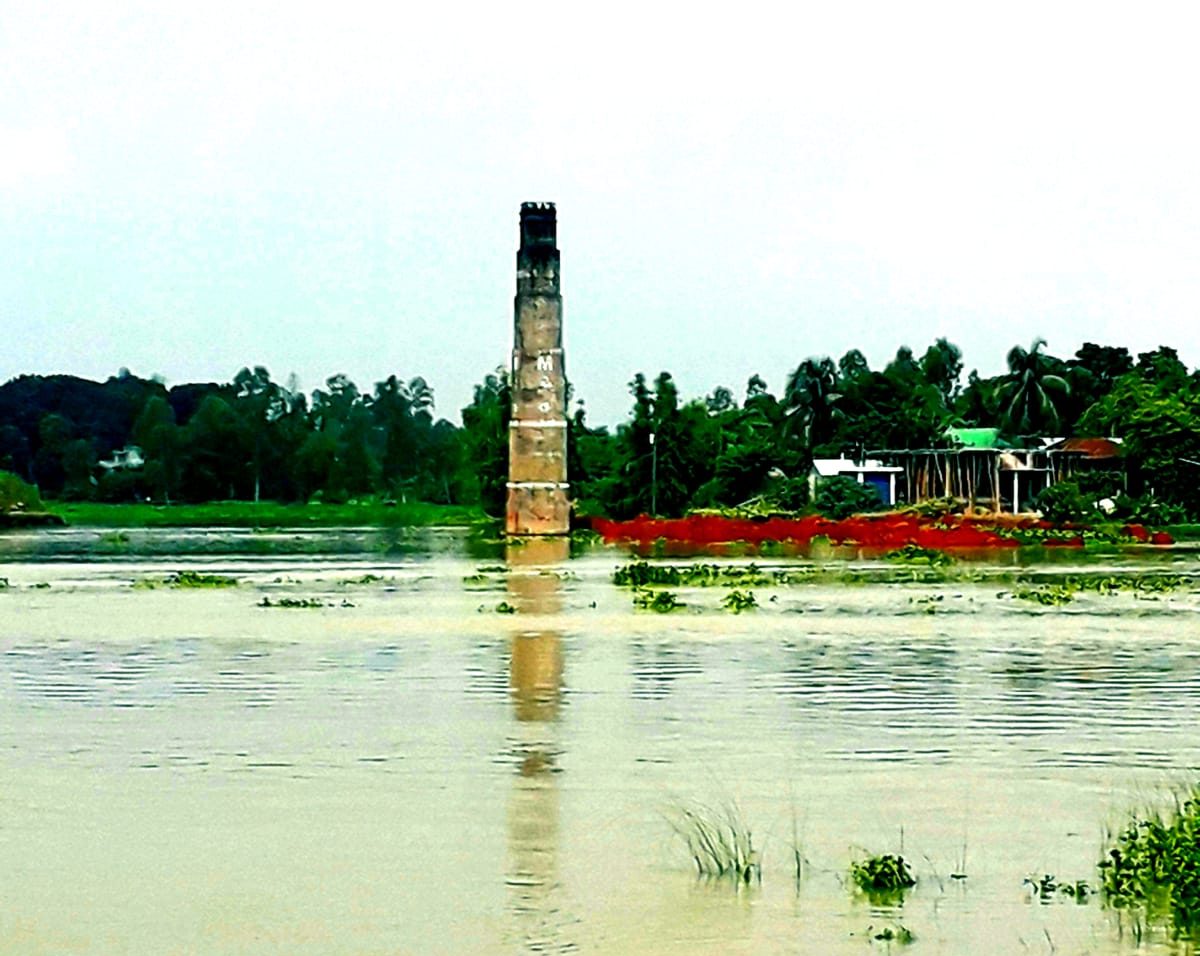
References
- Ecosystem related lecture by Professor Mohammad Zabed Hossain, Department of Botany, University of Dhaka.
- Scientific names and family name from Wikipedia.
Useful Links
Related Article
 Plantlet The Blogging Platform of Department of Botany, University of Dhaka
Plantlet The Blogging Platform of Department of Botany, University of Dhaka
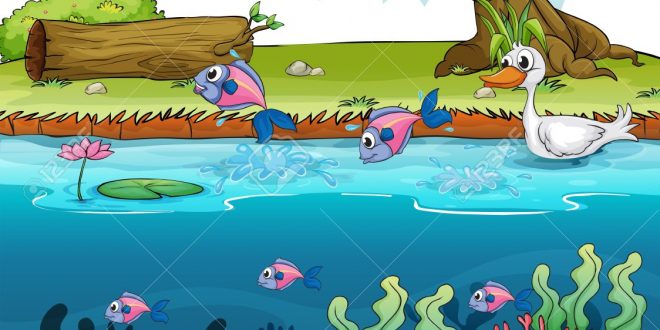

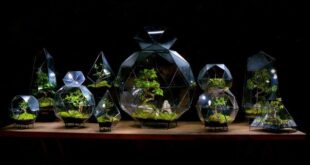
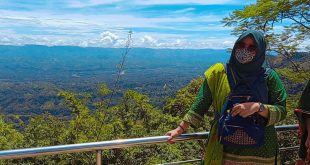
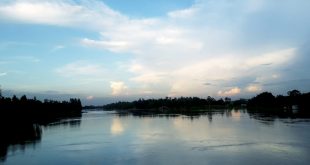
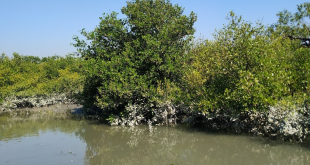
The point of view of your article has taught me a lot, and I already know how to improve the paper, thank you.